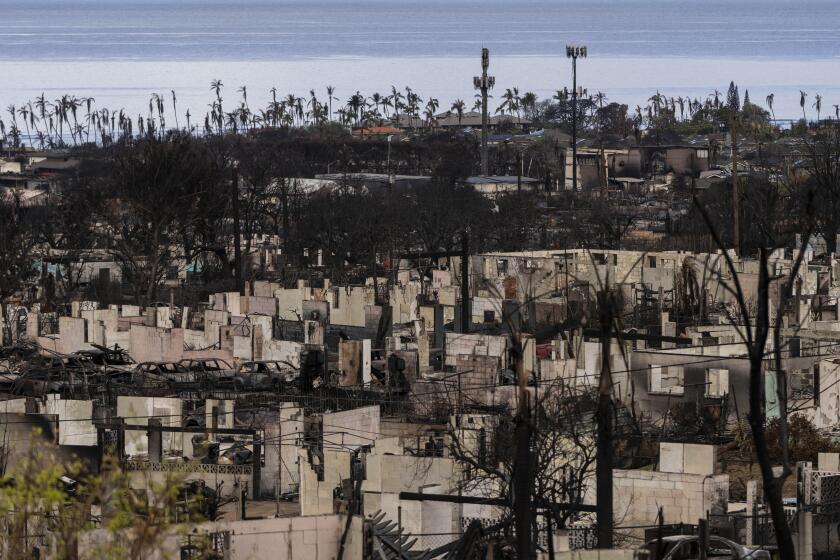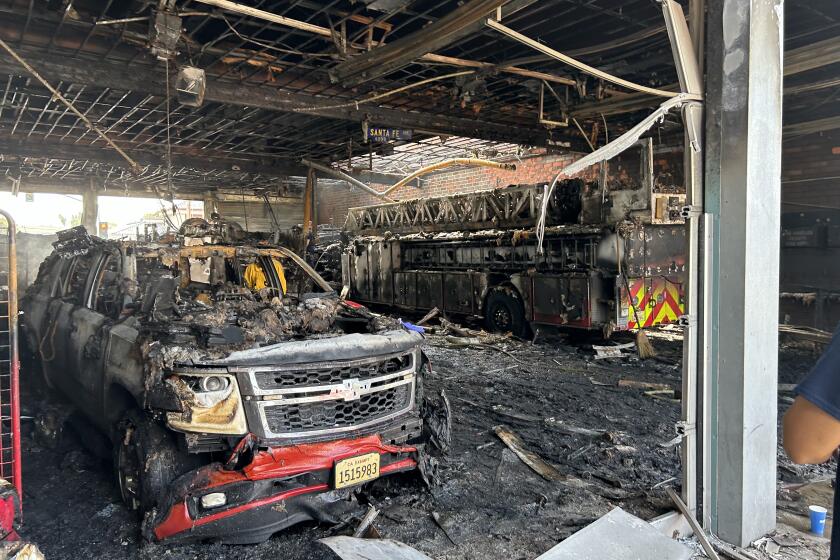With each fire, hamlet loses pieces of history
When fire chewed its way through the San Bernardino Mountains town of Running Springs last week, it was not the first time the little forest community had been ravaged by flames.
As with previous fires, the blazes destroyed some of the town’s heritage, including at least one of the original century-old cottages that date to the village’s origin as a swanky summer resort for the rich men and women of the Gilded Age.
What had been a site of logging operations in the latter part of the 19th century morphed into a summer resort in the late 1890s, luring affluent, adventure-seeking Southern Californians to the mountains.
Timber companies had for years found rich takings on the forested slopes. The biggest was a relative latecomer, Brookings Box and Lumber Co., built in 1896 by the family of Robert Brookings, who founded Washington University in St. Louis and Brookings Institution in Washington, D.C.
A year earlier, Redlands pioneer Alfred H. Smiley had bought 260 acres and built a summer resort featuring lectures and music programs. Smiley named the resort Fredalba, derived from his first name and that of his identical twin brother, Albert.
The Brookingses erected their sawmill right next to the resort.
Despite its noisy neighbor, Fredalba “was a Class A resort, where people thought they were roughing it in nearly a dozen Queen Anne-type cabins,” said Larry Burgess, director of the A.K. Smiley Public Library in Redlands.
To speed lumber operations, Brookings’ workers laid an eight-mile railroad track through rugged terrain to haul out the pine and fir.
A tiny Shay locomotive with a balloon-like smokestack hauled the felled trees down the narrow-gauge tracks to the mill next to Fredalba. Thousands of acres were cleared. Most of the lumber went to make orange crates to meet the demand of the Southland’s citrus growers.
“They cut everything but oak and cedar,” said Stan Bellamy, author of “Running Springs” and a board member of the Rim of the World Historical Society.
As the wealthy hunted and relaxed at Smiley’s resort, rustic cabins and tents were going up next door to house the mill workers and lumberjacks. The budding timber community also became known as Fredalba, and slowly the area turned into a company town.
Fredalba opened its first school in 1902, only to see much of the town’s structures destroyed by fire the next year.
In 1913, Brookings felled its last tree, and lumber mill workers moved to what is now Brookings, Ore., to build a new sawmill. The same year, fire destroyed Fredalba’s store and post office. The resort too had seen better days, with the Smiley family gradually having let it fall into decline.
“The resort became a victim of changing demographics,” Burgess said. “Lake Arrowhead started to attract a wealthier clientele. No one in the Smiley family wanted to take it over.”
Soon the resort became little more than a stop on the way to Big Bear.
But new life would soon come to the area. In the 1920s, a real estate syndicate bought more than 5,000 acres at $6 an acre and built a small business district, clubhouse and housing tracts it named Running Springs.
The community, which included Fredalba, soon boasted about 400 mostly part-time residents, including those living in a subdivision called Smiley Park.
During the Roaring ‘20s, Hollywood celebrities sought seclusion in the rugged terrain, 5,000 feet above the urban sprawl. Talent agent Myron Selznick, brother of producer David O. Selznick, built an 18-bedroom, 14-bathroom estate on about 40 acres. Half hunting lodge, half castle, it was said to have a wall where the rich and famous scrawled their names every time they came up for a weekend retreat, according to author John Robinson in his book “The San Bernardinos.”
Selznick called his 15,000-square-foot home Hill-Haven. It stood until 1991, when it too burned to the ground. Residents were shattered by the loss of what had become a familiar and beloved landmark.
“The fire was caused by young caretakers who were cooking drugs that got away from them,” author Bellamy said.
Hill-Haven was not the community’s only Hollywood connection, however. In the 1930s, Oscar-winning actor Walter Huston built a palatial home adjoining Selznick’s property. Guests flitted back and forth between the two estates.
In the 1960s, Huston’s property became a private boarding school for troubled teenagers. It closed a few years ago.
Just south of the Running Springs community of more than 5,000 full- and part-time residents sits the long-closed Cliffhanger Restaurant along the Rim of the World Highway, or California 18. It was prominently featured in this year’s thriller film “Next,” starring Nicolas Cage.
Somehow, the Cliffhanger hung on through last week’s fire, as did at least one of the cottages built by resort founder Smiley in 1896.
Richard Cox, who owns and lives in that cottage, marveled at his good fortune. In an e-mail last week, he noted that 36 of the 100-plus homes in Smiley Park were destroyed in the flames.
“My home . . . “ Cox wrote, “survived the fire.”
--
More to Read
Start your day right
Sign up for Essential California for news, features and recommendations from the L.A. Times and beyond in your inbox six days a week.
You may occasionally receive promotional content from the Los Angeles Times.






